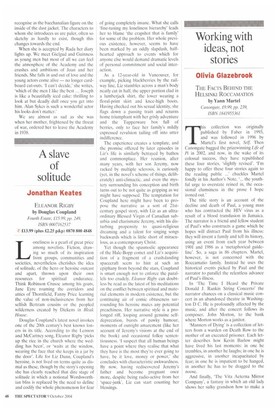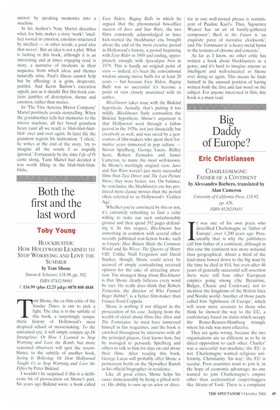Working with ideas, not stories
Olivia Glazebrook
THE FACTS BEHIND THE HELSINKI ROCCAMATIOS by Vann Martel Canongate, £9.99, pp. 239, ISBN 1841955361 This collection was originally published by Faber in 1993, and was followed in 1996 by Martel's first novel, Self. Then Canongate bagged the prizewinning Life of Pi in 2002, and now, in the wake of its colossal success, they have republished these four stories, 'slightly revised'. 'I'm happy to offer these four stories again to the reading public ...' chuckles Martel fondly in his Author's Note, '... the youthful urge to overstate reined in, the occasional clumsiness in the prose I hope ironed out.'
The title story is an account of the decline and death of Paul, a young man who has contracted the HIV virus as a result of a blood transfusion in Jamaica. The narrator is a friend and fellow student of Paul's who constructs a game which he hopes will distract Paul from his illness: they will invent a family and tell its history, using an event from each year between 1901 and 1986 as a 'metaphorical guideline'. So, a saga in 86 chapters. Martel, however, is not concerned with the Roccamatio family. Instead he uses the historical events picked by Paul and the narrator to parallel the relentless advance of Paul's illness.
In 'The Time I Heard the Private Donald J. Rankin String Concerto' the narrator chances on a classical music concert in an abandoned theatre in Washington D C. He is profoundly affected by the music, and after the concert follows its composer, John Morton, to the bank where Morton works as a janitor.
'Manners of Dying' is a collection of letters from a warden on Death Row to the mother of an executed prisoner. Each letter describes how Kevin Barlow might have lived his last moments: in one he trembles, in another he laughs; in one he is aggressive, in another incapacitated by fear; in one he is impatient to be hanged, in another he has to be dragged to the noose.
And finally, `The Vita Aeterna Mirror Company', a fantasy in which an old lady shows her sulky grandson how to make a mirror: by speaking memories into a machine.
In his Author's Note Martel describes what, for him, makes a story 'work': 'intellect rooted in emotion, emotion structured by intellect — in other words, a good idea that moves'. But an idea is not a plot. What is lacking in this book, although it is an interesting and at times engaging read, is story, a narrative of incidents in their sequence from which ideas and themes naturally arise. Paul's illness cannot help but be affecting: it is grim, desperate, painful. And Kevin Barlow's execution appals, just as it should. But this book contains jumbles of description, theme and emotion, rather than stories.
In 'The Vita Aeterna Mirror Company' Martel positively avoids storytelling. When the grandmother tells her memories to the mirror machine, all her bored grandson hears (and all we read) is 'blah-blah-blahblab' over and over again. In later life the grandson regrets his inattention. 'I often,' he writes at the end of the story, 'try to imagine all the words I so stupidly ignored.' Fortunately by the time Life of Pi came along, Yann Martel had decided it was worth filling in the blah-blah-blahblahs.



















































































































 Previous page
Previous page